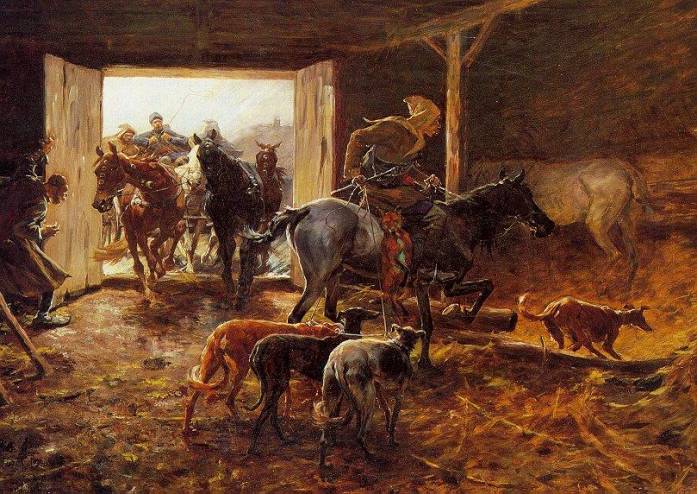
THE
CHART POLSKI

The breed is likely to originate from the ancient Asian Saluki, however,
its final appearance is an outcome of many crosses of greyhound types found in
the Polish territory.
In the hunting literature of 19th century, the name of “the Polish
greyhound” or “our greyhound” or “a common greyhound” is frequently
mentioned. The dog was supposed to be larger, stronger and with slightly longer
hair than the English Greyhound. The Polish greyhound was used to hunt different
game, mainly hare but also foxes, wolves and even deer. When hunting, the old
time hunters would often apply the so called “leash” i.e. two or three
cooperating greyhounds on the move.
A
detailed description of the Polish greyhound including information on its
upbringing, training for hunting, hunting methods as well as the dog’s picture
can be found in a Warsaw magazine Sylvan (1832/2). The writing of this first
real monograph on the breed is attributed to Wiktor Kozlowski. A few artists of
the 19th century portrayed dogs of the Polish greyhound type in their paintings,
including J. Kossak, J. Brandt and A. Wierusz-Kowalski; sketches of the dogs by
J. Norblin and L. Siemierski are preserved as well.
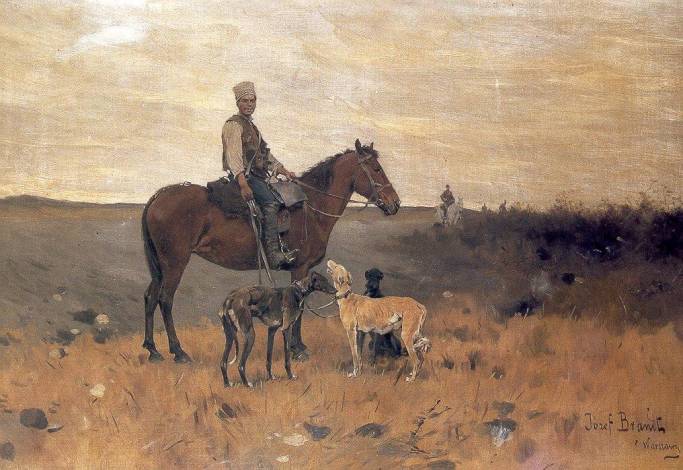
With the impoverishment of the Polish nobility, confining hunting with
greyhounds to large game preserves only and levying high taxes on greyhound
owners, the number of Chart Polski’s continually declined. At the end of the
19th century, the dogs could be hardly spotted. They managed to
survive in the Eastern part of the country and the Ukraine, where the were bred
under the name “chortaja borzoja” of “poskaja borzaja”. In the Southern
region of Poland, Chart Polski’s were used for hunting as long as the
outbreak of the Second World War. In 1971, Maciej Mroczkowski managed to obtain
information about Chart Polski’s living in the territory of the USSR, in the
Rostow region. After the October Revolution, the dogs were moved from large
private land estates to collective farms where, thanks to their hunting
qualities, they were pure bred. In 1972 Maciej Mroczkowski placed in a popular
Przekrój weekly an article about the greyhounds from Poland nowadays domiciled
in Ukraine and used for hare hunting by the soviet hunters. According to soviet
dog fanciers, the dogs numbered from several dozen to several hundred specimens.
In view of the game law banning hunting with greyhounds wich, at the time, was
about to be introduced in the USSR, the dogs faced extermination. Maciej
Mroczkowski’s article included an appeal addressed to the Przejkrój readers
asking for help to recreate the breed in our country. Luckily, the price for a
dog was relatively low, one dog could be purchased by as little as 30 or 40
rubels. Fifty readers responded, including Stanisław Czerniakowski from
Wrsaw who managed to purchase and bring to Poland two bitches named Tajga and
Striełka as well a dog called Elbrus. Tajga and Elbrus became parents of
the first puppies born in Poland.
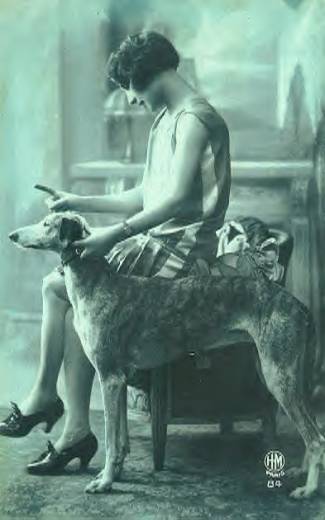
The first breeders of Chart Polski’s, Małgorzata and Izabella
Szmurło and Helena Jenczyk-Tołłoczko, put in their efforts to
obtain the dogs who survived in the South of Poland. It was quite a tough task,
though, because admitting to owning a greyhound automaticly meant admitted to
poaching, hunting with greyhounds in Poland is forbidden by law. Chart Polski’s
used to have many enemies, but also a large group of canine specialists who
favoured the breed. Commitment to popularise the breed was made by among others,
Hana Lipińska, a group of judges, including Lubomir Smyczyński,
Kazimierz Ściesiński and the re-discover of the breed Maciej
Mroczkowski. Owners of the first pedigree Chart Polski’s must be mentioned as
well, by presenting their dogs at shows they made it possible for everybody to
get familiar with the breed. Based on the relevant literature and iconography,
Hanna Lipińska and Małgorzata Szmurło developed a draft standard
of the breed. On opening the Chart Polski Pre-register Book of 1981, 30 dogs
were enrolled. The same number of dogs entered the 1st Chart Polski
National Specialty Show witch was held in Poznan in 1981 and during witch three
generations of the dogs were exhibited. A year later, the Pre-register Book
included as many as 60 dogs. The breed received a preliminary approval of FCI at
the Federation General Congress held in Helsinki in 1989. The Chart Polski breed
standard is listed under the number 333, it is not eligible for CACIB yet. A
year later, first dogs of the Chart Polski breed were exhibited at the
international show in Switzerland. Because of the ban on hunting with greyhounds,
the dogs are not used for hunting purposes any longer, nevertheless, they are
very popular with track racing and coursing. When running, the Chart Polski is
as speedy as the English Greyhound but even more enduring.
The
top breediners of the Chart Polski’s are Małgorzata and Izabella
Szmurło whose “Celerrimus” Kennel excels in the number of pedigree
puppies. The ladies promote the breed inside and outside the country; they are
the autors of many specialist articles on the breed as well as of the monograph
Chart Polski (The Polish Greyhound)) published in 1993. Other outstanding
kennels include “Od Charciarza”, “Z Wielgowa”, “Ranbaza”, “Czereda
Kusego”, “Ksenas” and others. The Chart Polski aroused much interest in
the USA, Finland, Belgium, France, The Netherlands, Germany and Denmark, where
the first litters have already been reported. Individual specimens have been
sent to Canada and Sweden. In 1984, the Chart Polski Club was set up; similar
clubs operate in France, Belgium and USA.
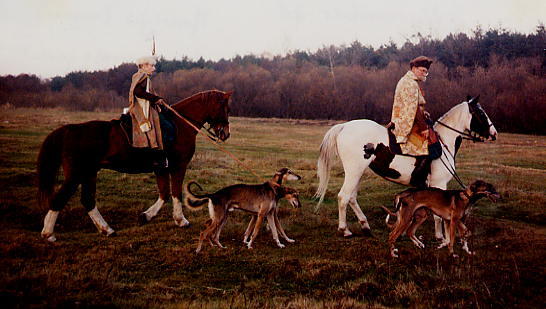
This
is the Sint Hubertus hunt in Poland (2000). The father of Luna Nowy (Harap) and
both parents of Łoza (Filutek and Galicja) were competitors.

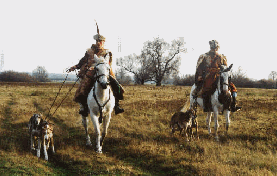
CHART
POLSKI BREED STANDARD (SHORTENED)
The Chart Polski is a large,
strong and muscular dog, whose outline is much more robust and less noble than
of other shorthaired greyhounds. In its outline the Chart Polski resembles its
ancestor, the Asian Greyhound. Powerful bones, compact body, prominent
musculature and strong jaws, evidence that the dog was used in the difficult
conditions of the Polish climate for hunting not only hares, foxes, deer and
bustards but wolves as well. Eyes are of paramount importance for the breed,
their expression should be sharp, alert and piercing. Gaits must be fluid and
springy; correct angulation of fore and hind legs allows long, free pace both
when walking and trotting. The Chart Polski is eventempered, trusting, reserved
and brave. When in chase, the dog is fast, very agile and rentless; his
reactions are quick and ruthless.
Height at he withers:
bitches 68 –75 cm, dogs 70 – 80 cm. Specimens taller than the optimal height
are desired, provided thir typical exterior is maintained. Body leght to height
at the withers ratio should be that of 102 – 105%.
Head:
strong, lean and long; the leght of the muzzle to the leght of the skull should
be that of 1 ; 1 (slightly longer muzzle is permitted); the skull cranial region
should be flat, stop scarcely perceptible, suproarbital ridges, frontal furrow
slightly pronounced; the topline of the muzzle and the skull should be slightly
diverging; the frequently found feature of a Roman nose is desired; the muzzle
strongly tapering towards the tip of the nose should not give an impression of
being pointed but blunt; tip of the nose black or dark, large, protruding past
the line of the lips; jaws and teeth strong positioned in a scissors bite, level
bite permitted.
Eyes:
dark coloured eyes are valued; depending on the coat colour, the iris colour can
range from dark brown to amber; eyes clear fairly large.
Ears:
of medium size, quite norrow, when extended, their tips easely reach the inner
eyecorner; set on at the eye level.
Neck:
long, muscular and strong, oval in cross section; rising gently from the withers
line, head carried rather gigh.
Body:
withers small but well pronounced; topline straight above the chest and slightly
arched above the loins; chest very deep and capacious, seen frontally,
moderately broad, ribs should be well sprung but not rounded; belly tucked up;
loins broad and muscular; croup moderately sloping, long and well-muscled.
Tail:
long, thick at the base; in repose, carried low with the tip curled upwards to
form a sickle or a wheel; when alert, the tail can be carried slightly higher.
Forequarters:
long, lean and muscular limbs set apart fairly narrowly; when seen frontally,
the limbs should be parallel; long forearm; metatarsus slightly slanting in
relation to the ground; feet oval, toes tight.
Hindquarters:
long and muscular limbs, fairly well angulated; positioned slightly backwards
and sideways but to a lesser degree than with the English Greyhound; when seen
from the rear, the limbs should be parallel; lower thigh long, strong hock, feet
oval but more elongated then forefeet.
Coat:
the hair is springy to touch, quite hard, neither wiry nor silky; hair of
different length; usually longer on the withers and shorter on sides, the
shortest on sterum and limbs; backside of the tights and backside of the tail
are covered with the longest hair.
Colour
alle colours are permitted.
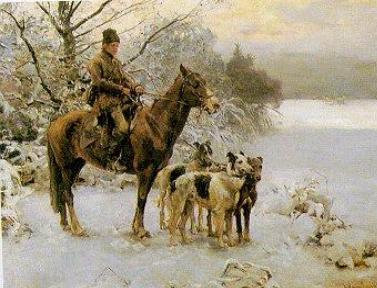
Luna Nowy Celerrimus (Luna)
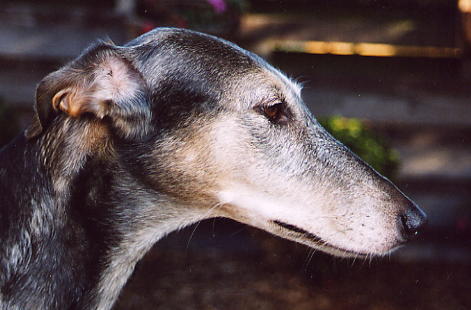
Luna
was our first Chart Polski. Her pedigree name is Luna Nowy Celerrimus. Years ago in Belgium we saw the famous Chart Polski of
mrs. Peeters (worldchampion Topola),
and we fell in love. After a lot of questions and answers we went to Poland and
got Luna in juli 1998 from Goska and Iza. Luna was very sweet and crazy about our
whippets. Running, playing and racing through water gave her much pleasure. In
2008 Luna past away.
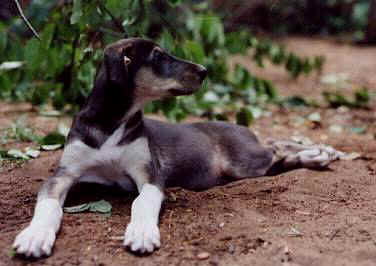
Luna as a puppy
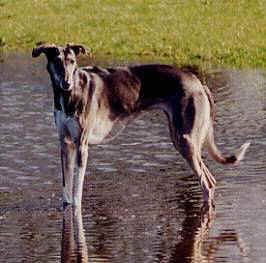
Luna loved water
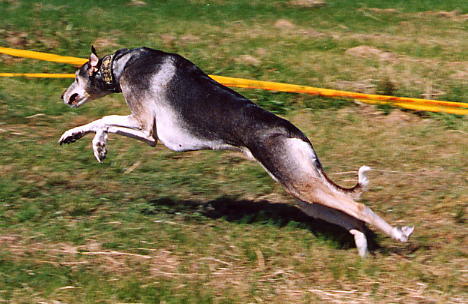
Łoza Celerrimus (Jagoda)
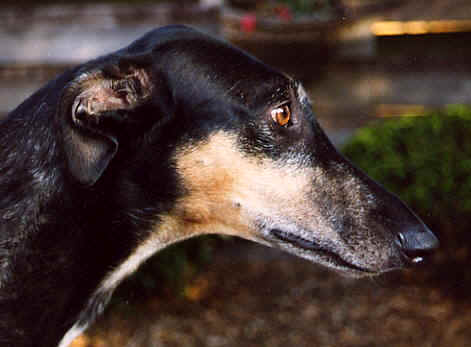
After a while we wanted a second Chart Polski. After a lot of emails with Goska and Iza we got Jagoda in Poznan at the Eurodog show. At the time she was 8 months old and the litterchoice of the breeders. Jagoda’s pedigree name was Łoza Celerrimus. To get a somewhat older dog is always a bit of a gamble, specially when they don’t know a lot about the big world. Jagoda however has proven to be a class dog, she adapted well and she was the bodyguard of our group. She had a very strong character, she was a winner.

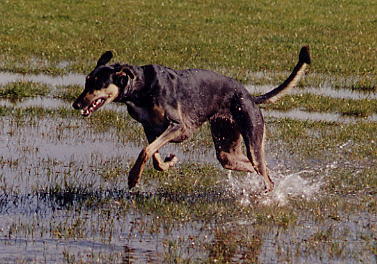
Jagoda running in Spaarnewoude
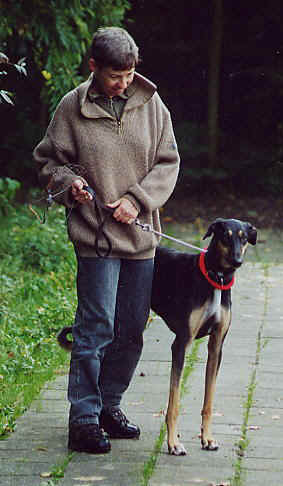
Femia and Jagoda waiting at a race
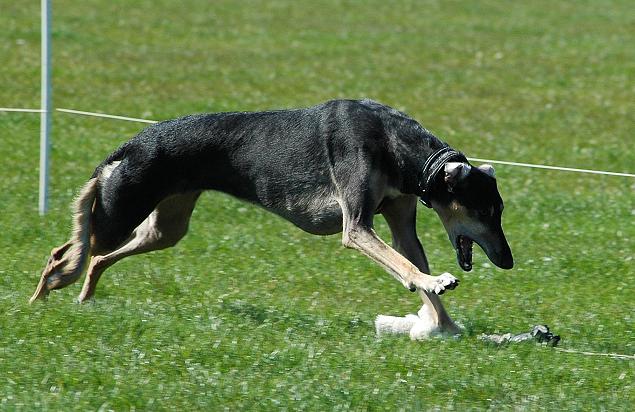
Jagoda is going for the "hare"
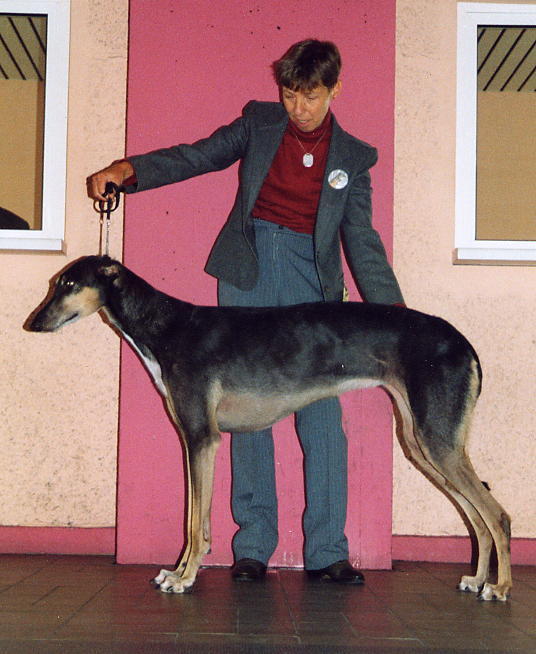
she was beautifull